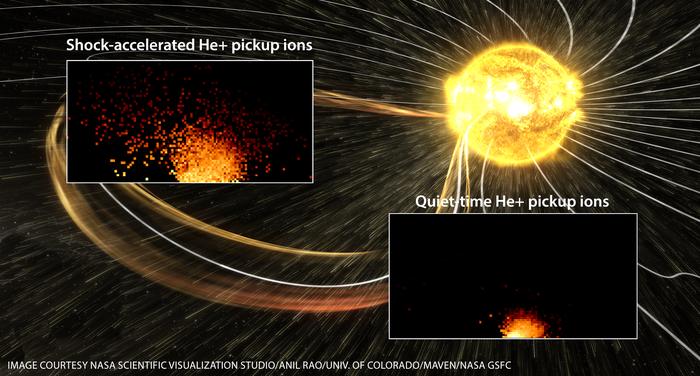In a groundbreaking advancement for heliophysics and space weather research, scientists from Southwest Research Institute (SwRI) have unveiled new insights into the behavior and acceleration mechanisms of helium pickup ions within interplanetary coronal mass ejection (CME) structures. Led by Dr. Keiichi Ogasawara, this pioneering study reveals how these pickup ions serve as critical progenitors of solar energetic particles (SEPs), which pose significant radiation hazards for astronauts and spacecraft navigating the volatile environment of our solar system.
At the core of this discovery lies an intricate understanding of pickup ions—charged particles formed when neutral atoms traveling from interstellar space are ionized by solar ultraviolet radiation. Unlike the continuous solar wind plasma emitted by the Sun’s corona, pickup ions possess a distinct velocity distribution pattern. They are ensnared by the magnetic fields embedded in the solar wind, and under specific conditions, particularly during CME activity, they experience dramatic acceleration, resulting in high-energy SEPs that traverse space at speeds much greater than previously documented.
Utilizing data from NASA’s Solar Terrestrial Relations Observatory (STEREO), the research team meticulously charted the velocity evolution of helium pickup ions through multiple CME events. This allowed them to capture, for the first time, the nuanced stages of energy transfer and acceleration that these ions undergo as they interact with dynamic interplanetary shocks and magnetic structures. These observations offer unprecedented clarity on how solar activity imprints upon particle behavior in the heliosphere, fundamentally altering the landscape of space weather forecasting.
“One of the most surprising elements of our findings is the distinctive velocity distribution of helium pickup ions,” explains Dr. Ogasawara. “Even during periods of relatively calm solar wind, these ions exhibit speeds twice that of the background solar wind plasma. This intrinsic velocity advantage primes pickup ions for more efficient acceleration during shock passages, effectively acting as seed populations for generating the most energetic particles unleashed by solar eruptions.”
To dissect these intricate processes, SwRI researchers devised innovative analytical methods capable of partitioning the observed particle velocity changes into components reflecting energy gain, energy loss, and energy conservation. This methodological breakthrough enabled detailed mapping of how different interplanetary structures such as CME-driven shocks, turbulent plasma regions, and compressed sheath zones ahead of ejecta distinctly influence ion energization mechanisms.
Understanding the acceleration of helium pickup ions carries profound implications beyond academic interest. As SEPs attain elevated energies, they possess the penetrating power necessary to compromise spacecraft electronics and increase radiation exposure for astronauts, potentially threatening missions aiming to explore further reaches of the solar system and beyond. Insights from this study thus contribute directly to enhancing protective measures and predictive models relevant to human spaceflight safety.
The differentiation between pickup ions and normal solar wind particles extend further into their spatial behavior within the heliosphere. The team noted that pickup ions respond sensitively to the orientation of local magnetic fields, displaying characteristic velocity distributions that vary according to the shock type encountered. This sensitivity underscores the complex magnetic topology shaping solar particle acceleration and points toward refined scenarios that incorporate heliospheric magnetic architecture in SEP modeling.
By establishing these detailed observational constraints, Dr. Ogasawara’s study illuminates the non-linear, multi-scale phenomena governing particle acceleration in our star’s extended environment. These revelations mark a significant step forward in disentangling the interrelated plasma and magnetic dynamics responsible for shaping the solar energetic particle landscape and magnetic structure evolution in the inner heliosphere.
The research, published in The Astrophysical Journal, opens avenues for further exploration of particle acceleration physics using a combination of in situ spacecraft measurements, theoretical plasma modeling, and advanced simulation techniques. Continued investigation into helium pickup ion dynamics promises to refine our understanding of fundamental astrophysical processes relevant not only to our solar system but to astrophysical plasmas throughout the galaxy.
Moreover, with increasing human and robotic activity planned in near-Earth space and beyond, the ability to predict and mitigate the effects of high-energy solar particles assumes heightened importance. The methodologies and insights delivered by this study empower space weather scientists with enhanced tools to forecast SEP events and tailor mitigation strategies, safeguarding technological assets and human explorers alike.
In conclusion, the identification of helium pickup ions as pivotal contributors to solar energetic particle production expands the known sources of space radiation and reshapes perspectives on heliospheric particle acceleration. This research exemplifies the power of combining advanced observational platforms with innovative analytic approaches to unravel complex space physics challenges. As we deepen our engagement with the solar environment, such discoveries will be vital to advancing space exploration and protecting the next generation of astronauts.
—
Article Title: Helium Pickup Ion Velocity Distributions Observed in Interplanetary Coronal Mass Ejection Structures
News Publication Date: 25-Feb-2025
Web References:
https://www.swri.org/markets/earth-space/space-research-technology/space-science/heliophysics
References:
DOI: 10.3847/1538-4357/adb1b4
Image Credits:
NASA Scientific Visualization Studio / ANIL RAO / Univ. of Colorado / MAVENNA / NASA GSFC
Keywords
Helium, Solar energy, Solar wind, Heliosphere, Solar physics, Solar flares
Tags: astronaut radiation hazardsCME velocity evolutioncoronal mass ejections studyheliophysics advancementshelium pickup ions researchhigh-energy particle behaviorinterstellar neutral atoms ionizationmagnetic field interactions in spaceNASA STEREO data analysissolar energetic particles accelerationsolar wind and pickup ionsspace weather implications





